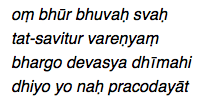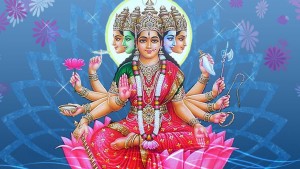
Japa is the chanting or repetition of a mantra, which is a kind of prayer. Japa is also a meditation on the sound of the mantra. Perhaps the best example of japa is the chanting of the Hare Krishna mantra: hare krishna, hare krishna, krishna krishna, hare hare; hare rama, hare rama, rama rama, hare hare. Another mantra that is commonly recited as japa is the gayatri mantra. Usually some means of counting is employed such as a set of beads like a rosary set. Such beads are called a japa mala and a devotee may follow a vow to recite a mantra a specific number of times a day as part of his or her personal spiritual practice, sadhana. A set of Hindu chanting beads generally contains 108 beads. Such beads may be made of sandalwood, crystal or in the case of Shaivas rudraksha seeds or in the case of Vaishnavas tulasi wood. You may often hear the expression mantra-yoga or japa-yoga to mean that one is using the recitation of mantras as one’s main spiritual practice.
 The next ceremony is anna prashanam, which is the first grains ceremony. This is the child’s first solid food generally performed in the sixth month. A child is brought to a temple, or a a priest is invited to the family’s home, and along with mantras and a sacred fire, food (usually a sweet rice preparation) is offered to God through the fire and “made” into prasada. The prasada is then fed to the child. In other words, the child’s first solid food is prasada, blessed food.
The next ceremony is anna prashanam, which is the first grains ceremony. This is the child’s first solid food generally performed in the sixth month. A child is brought to a temple, or a a priest is invited to the family’s home, and along with mantras and a sacred fire, food (usually a sweet rice preparation) is offered to God through the fire and “made” into prasada. The prasada is then fed to the child. In other words, the child’s first solid food is prasada, blessed food.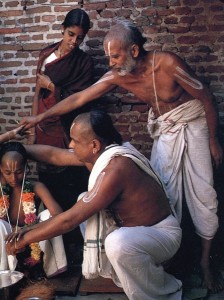
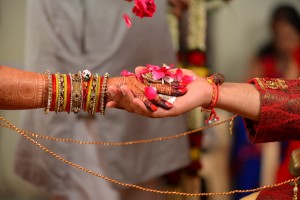 Moving along in a chronological way the next import samskara is marriage. This is called vivaha. As in virtually all cultures the marriage ceremony involves a bride and groom coming together in the presence of family and friends and then taking an oath of dedication to each other. In Sanskrit the word vivaha comes from the root vah, which means to carry. The oath of dedication that the bride and groom take to each other is a contract that “carries” them along for the remainder of their lives. Most Hindu weddings involve an exchange of garlands between the bride and groom (jaya mala), a bestowal of the bride by her father to the groom (kanya dhana), the lighting of a sacred fire (havan), circumambulation of the fire (parikramana), and the taking of seven vows (sapta padi). In general southern marriages have the addition of a sacred necklace given to the bride by the groom (mangala sutra), and northern weddings have the addition of a sacred mark of vermilion applied by the groom to the bride in the parting of her hair (sindhura). There are, of course, huge variations between weddings, and many other aspects that we have not mentioned, especially in India where a ceremony can last many hours. In the West the average wedding lasts about an hour. For more detailed information see The Hindu Wedding.
Moving along in a chronological way the next import samskara is marriage. This is called vivaha. As in virtually all cultures the marriage ceremony involves a bride and groom coming together in the presence of family and friends and then taking an oath of dedication to each other. In Sanskrit the word vivaha comes from the root vah, which means to carry. The oath of dedication that the bride and groom take to each other is a contract that “carries” them along for the remainder of their lives. Most Hindu weddings involve an exchange of garlands between the bride and groom (jaya mala), a bestowal of the bride by her father to the groom (kanya dhana), the lighting of a sacred fire (havan), circumambulation of the fire (parikramana), and the taking of seven vows (sapta padi). In general southern marriages have the addition of a sacred necklace given to the bride by the groom (mangala sutra), and northern weddings have the addition of a sacred mark of vermilion applied by the groom to the bride in the parting of her hair (sindhura). There are, of course, huge variations between weddings, and many other aspects that we have not mentioned, especially in India where a ceremony can last many hours. In the West the average wedding lasts about an hour. For more detailed information see The Hindu Wedding.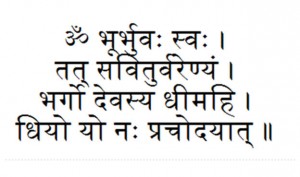 The famous gayatri mantra that almost every Hindu knows first appears in the Rig Veda (iii /62/10). In roman letters it is as follows:
The famous gayatri mantra that almost every Hindu knows first appears in the Rig Veda (iii /62/10). In roman letters it is as follows: